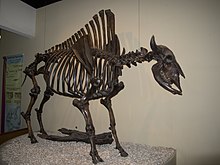Ancient bison
|
Bison antiquus Temporal range: 0.24–0.009 Ma |
|
|---|---|
 |
|
| Bison antiquus | |
| Scientific classification | |
| Kingdom: | Animalia |
| Phylum: | Chordata |
| Class: | Mammalia |
| Order: | Artiodactyla |
| Family: | Bovidae |
| Subfamily: | Bovinae |
| Genus: | Bison |
| Species: | †B. antiquus |
| Binomial name | |
|
Bison antiquus Leidy, 1852 |
|
Bison antiquus, sometimes called the "Ancient bison", was the most common large herbivore of the North American continent for over 10,000 years, and is a direct ancestor of the living American bison.
During the later epoch, between 240,000 and 220,000 years ago,steppe wisent (B. priscus) migrated from Siberia into Alaska. This species inhabited parts of northern North America throughout the remainder of the Pleistocene. In midcontinent North America, however, B. priscus was replaced by the long-horned bison, B. latifrons, and somewhat later by B. antiquus. The larger B. latifrons appears to have died out by about 20,000 years ago. In contrast, B. antiquus became increasingly abundant in parts of midcontinent North America from 18,000 ya until about 10,000 ya, after which the species appears to have given rise to the living species, B. bison.B. antiquus is the most commonly recovered large mammalian herbivore from the La Brea tar pits.
B. antiquus was taller, had larger bones and horns, and was 15-25% larger overall than modern bison. It reached up to 2.27 m (7.5 ft) tall, 4.6 m (15 ft) long, and a weight of 1,588 kg (3500 lb). From tip to tip, the horns of B. antiquus measured about 3 ft (nearly 1 m).
One of the best educational sites to view in situ semifossilized skeletons of over 500 individuals of B. antiquus is the Hudson-Meng archeological site operated by the U.S. Forest Service, 18 miles (29 km) northwest of Crawford, Nebraska. A number of paleo-Indian spear and projectile points have been recovered in conjunction with the animal skeletons at the site, which is dated around 9,700 to 10,000 years ago. The reason for the "die-off" of so many animals in one compact location is still in conjecture; some professionals argue it was the result of a very successful paleo-Indian hunt, while others feel the herd died as a result of some dramatic natural event, to be later scavenged by humans. Individuals of B. antiquus of both sexes and a typical range of ages have been found at the site.
...
Wikipedia
